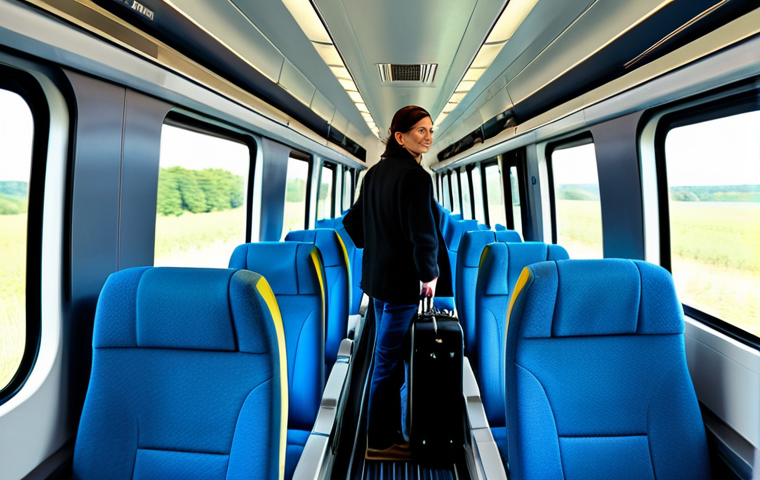There’s something uniquely enchanting about high-speed rail travel in Europe, isn’t there? The thought of gliding through picturesque French landscapes on a TGV, sipping a coffee, with tiny villages blurring past your window – it’s the quintessential European dream.
I vividly recall my first TGV journey from Paris to Nice; the anticipation, the sheer speed, and honestly, the slight panic of *actually* booking the ticket.
It felt like navigating a labyrinth, especially trying to snag one of those coveted cheap ‘PREM’s’ fares that vanish quicker than a crêpe on a hungry morning.
In today’s world, with so many of us consciously opting for sustainable travel over short-haul flights, the TGV has become more popular than ever, leading to dynamic pricing that can feel like a game of high-stakes poker.
One moment a ticket is €50, the next it’s €150! It’s enough to make anyone second-guess their plans. We’re living in an era where digital tools are supposed to make life easier, yet booking these trains can still throw you for a loop if you don’t know the tricks of the trade, from deciphering the SNCF Connect app to understanding flexible tickets versus non-exchangeable ones.
The future of travel increasingly leans on seamless, connected experiences, and mastering TGV bookings now sets you up for effortless adventures across France and beyond.
No one wants to be caught at the Gare de Lyon frantically trying to rebook a missed connection. Trust me, I’ve seen it happen, and it’s not pretty. My aim here is to cut through the confusion and arm you with the insider knowledge to make your TGV journey as smooth as the ride itself.
Ready to unlock the secrets to stress-free TGV reservations, ensuring you get the best seats and fares without the typical headaches? Let’s get into the specifics.
Deciphering the TGV Ticket Labyrinth: Types and Timing

Navigating the various TGV ticket options can feel like trying to solve a Rubik’s Cube blindfolded, especially for first-timers. I remember distinctly my early days of trying to book a TGV from Avignon to Paris.
I kept seeing different fare names and prices fluctuating wildly, and it was genuinely confusing. It’s not just about getting from A to B; it’s about understanding the nuances of each fare type to maximize your savings and flexibility.
My goal when I first started traveling extensively by TGV was always to land one of those super cheap ‘PREM’ fares, and let me tell you, that hunt was intense!
But beyond ‘PREM,’ there’s a whole spectrum of choices, each designed for a specific type of traveler or situation, from the spontaneous weekend getaway to the meticulously planned business trip.
Knowing the ins and outs of each can save you not just euros but also a fair bit of stress down the line. It’s about empowering you to make informed decisions rather than just clicking the cheapest option and hoping for the best, because sometimes, the cheapest option isn’t always the *best* value when you factor in potential changes or cancellations.
1. The Elusive ‘PREM’ and Other Non-Flexible Fares
Ah, the ‘PREM’ ticket. This is the holy grail for budget-conscious travelers. When I manage to snag one of these, I feel like I’ve won the lottery.
They’re typically released several months in advance, often as early as three to four months before departure, sometimes even more for peak seasons like summer or Christmas.
The catch? They’re usually non-exchangeable and non-refundable, or come with hefty fees for any changes, making them ideal only if your plans are set in stone.
I learned this the hard way once when a last-minute meeting popped up and I had to forfeit a perfectly good ‘PREM’ ticket. It stung, truly. Then there are other similar non-flexible fares that might pop up, sometimes branded slightly differently but essentially offering the same low price for zero flexibility.
These are perfect for those cross-country trips where you know exactly when and where you’re going. Always, always double-check the terms and conditions before committing to one of these; it’s the fine print that often trips people up.
2. Understanding Standard, Business Première, and Carte Avantage
Beyond the ‘PREM’ fares, you’ll encounter ‘Standard’ tickets, which offer a moderate level of flexibility, often allowing changes or cancellations for a fee.
They’re a solid middle-ground option for many travelers. Then there’s ‘Business Première,’ which is, as the name suggests, a premium experience. I splurged on one of these once for a really long journey from Paris to Marseille, and honestly, the extra legroom, the included meal, and access to the lounge made a world of difference.
If you’re traveling for work, or simply want a more relaxed and comfortable journey, ‘Business Première’ is fantastic, especially if you value onboard services and flexibility.
It typically allows for free changes and refunds, even at the last minute. Lastly, for frequent travelers, the ‘Carte Avantage’ loyalty cards (Jeune, Adulte, Senior, Famille) are absolute game-changers.
I got the ‘Carte Avantage Adulte’ last year, and the guaranteed discounts (minimum 30% off for the cardholder and one accompanying adult on many fares) quickly paid for themselves.
Plus, they cap the prices for last-minute bookings, which is a lifesaver for spontaneous trips. It’s an investment, but one that genuinely pays off if you plan to make more than a couple of TGV journeys within France over a year.
Navigating the Digital Booking Landscape: Where to Click
In an age where everything is supposed to be at our fingertips, the sheer number of platforms for booking TGV tickets can be overwhelming. It’s not just about finding a website; it’s about finding the *right* website that offers the best prices, the most seamless experience, and doesn’t hit you with hidden fees.
I’ve personally tried almost all of them, from the official French rail operator’s often-temperamental app to third-party resellers promising the world.
Each has its quirks, its pros, and its cons. My journey to finding the ideal booking method was definitely one of trial and error, involving frustrating error messages and sometimes, much higher prices than I anticipated.
Understanding the differences between these platforms can genuinely make or break your booking experience, determining whether it’s a smooth ride or a series of irritating roadblocks.
It’s not just about where to buy, but also how to interpret the information presented to you on these diverse interfaces.
1. The Official Channel: SNCF Connect (and its Quirks)
SNCF Connect is the official platform for booking TGV tickets in France, and for French speakers, it’s often the go-to. However, for international travelers, it can sometimes be a bit…
challenging. I remember spending a good half-hour trying to figure out why my credit card wasn’t being accepted on their old website version. The interface, while much improved recently, can still be a bit clunky, especially when trying to apply discount cards or understand complex journey details.
On the plus side, it usually shows the most comprehensive range of direct SNCF fares, including all the ‘PREM’ and promotional prices first. It’s also the best place to manage your e-tickets directly and, crucially, to see real-time service updates or disruptions.
My advice? If you’re comfortable with a slightly less user-friendly experience in exchange for direct access to all official fares and information, this is your primary tool.
It’s definitely improved, but still occasionally gives me a moment of pause.
2. User-Friendly Third-Party Platforms: Trainline and Omio
For sheer ease of use, I often find myself gravitating towards platforms like Trainline or Omio. These aggregators are like the universal translators of European rail travel.
They combine tickets from multiple operators, including SNCF, into one simple interface, making it incredibly easy to compare prices and routes. I’ve found Trainline to be particularly intuitive; its mobile app is fantastic for last-minute bookings or checking details on the go.
The small service fee they might charge is often a worthwhile trade-off for the convenience and clarity they offer, especially when dealing with complex international journeys or connecting trains operated by different companies.
For example, when I was planning a trip involving TGV and a regional TER train, Trainline showed me the entire journey on one ticket, something the SNCF app sometimes struggles to do seamlessly.
Omio is another solid choice, particularly good for comparing train, bus, and even flight options side-by-side, which can be super useful if you’re flexible with your mode of transport.
These platforms often make the booking process so much less intimidating, reducing that familiar pre-travel anxiety.
Unlocking the Best Deals: Timing, Flexibility, and Smart Strategies
It’s no secret that TGV prices can fluctuate wildly. One day a ticket is €30, the next it’s €100 for the exact same journey! This dynamic pricing model can be incredibly frustrating if you don’t know how to play the game.
I’ve personally felt the sting of paying double what a friend paid for the same route just because I booked a week later. It feels like a high-stakes auction, and mastering it requires a bit of savvy, some patience, and sometimes, a dash of daring.
It’s not just about booking early, though that’s a huge part of it; it’s about understanding the invisible forces that drive ticket prices up and down and learning to leverage them to your advantage.
This means knowing when new tickets are released, understanding peak vs. off-peak travel, and being flexible enough to grab those fleeting deals that disappear quicker than a fresh baguette on a Sunday morning.
1. The Golden Rule: Book Early, But Not Too Early (Sometimes)
The general wisdom for TGV bookings is to book as early as possible. SNCF typically releases tickets in batches, usually 3-4 months in advance, but sometimes up to 6 months for major routes or peak holiday periods.
This is when the cheapest ‘PREM’ fares are most abundant. I’ve found that setting up a price alert (some third-party apps like Trainline offer this) is incredibly useful.
You get notified the moment tickets go on sale for your desired route and date, giving you a head start. However, here’s a slight twist: sometimes, new batches of tickets or special promotions are released closer to the departure date, especially if initial sales are slow.
While rare for prime routes, I’ve occasionally stumbled upon unexpected deals a few weeks out. This is a gamble, though, and generally, for popular routes and times, early bird truly gets the worm.
My strategy is always to book my core journeys early and then keep an eye out for any surprising drops if my plans allow for a bit of last-minute tweaking.
2. Leveraging Off-Peak Travel and Price Alerts
The time of day, day of the week, and even the season profoundly impact TGV fares. Traveling during mid-week (Tuesday, Wednesday, Thursday) is almost always cheaper than weekends.
Similarly, avoiding peak commuting hours (early morning and late afternoon) can lead to significant savings. My personal trick is to aim for mid-day trains or even early evening trains that aren’t quite rush hour.
I’ve seen prices halve just by shifting my departure time by an hour or two. Utilizing price alerts, as I mentioned, is crucial. Set them up for a range of dates and times if you have flexibility.
Also, consider lesser-known routes or connections. Sometimes, taking a slightly longer route with a transfer can be surprisingly cheaper than a direct high-speed train, especially if you’re not in a huge rush.
And always, always clear your browser cookies or use incognito mode when checking prices repeatedly; dynamic pricing algorithms can sometimes “remember” your searches and subtly increase prices.
Mastering Your Onboard Experience: Seating, Luggage, and Comfort
Once you’ve navigated the booking maze, it’s time to think about the journey itself. The TGV experience is about more than just getting from point A to point B; it’s about the comfort, the views, and making the most of your travel time.
I’ve had journeys where I felt completely relaxed and others where I was constantly shifting, trying to find a comfortable spot. A big part of this comes down to understanding your seating options and how to best manage your luggage, which can significantly impact your overall enjoyment of the ride.
Trust me, trying to cram an oversized suitcase into a tiny overhead rack while a queue of impatient passengers forms behind you is not how you want to start your relaxing vacation.
Knowing these details beforehand can make your journey feel effortless and truly enjoyable.
1. Choosing Your Perfect Seat: From Quiet Cars to Upper Decks
TGV trains offer a surprising variety of seating preferences. When booking, you often have the option to select specific seats. Do you prefer a window seat to gaze at the blurring landscapes?
Or an aisle seat for easy access to the restrooms or café car? My personal preference on a double-decker TGV Duplex is almost always the upper deck (l’étage) for unparalleled views – it genuinely feels like floating above the countryside.
If you’re traveling for work or simply want a peaceful journey, look for the ‘Espace Calme’ (Quiet Car) – it’s a blessing for those who want to avoid loud phone conversations or boisterous groups.
For families, there are often ‘Espace Famille’ sections with tables, perfect for games or a picnic. Don’t underestimate the power of a good seat choice; it can transform a long journey from tedious to truly pleasant.
I always take a few extra minutes during booking to review the seat map, envisioning myself settled in.
2. Luggage Logistics: What to Bring and Where to Stash It
While TGVs are generally generous with luggage allowances compared to airlines, it’s not a free-for-all. You’re typically allowed two large pieces of luggage plus a small carry-on, but there aren’t strict weight limits like on planes.
The key is managing it efficiently. My top tip: utilize the luggage racks at the ends of the carriages for larger bags. Don’t be that person trying to squeeze a huge suitcase into the overhead racks above your seat; those are generally for smaller items like backpacks or briefcases.
I learned this when I first traveled with a massive trekking backpack; it simply wouldn’t fit, and I had to awkwardly drag it to the end of the car. For smaller items you need during the journey, like a book, snacks, or headphones, keep them in a small bag under your seat or in the overhead compartment.
It makes for a much smoother boarding and disembarking process.
Navigating the Station and Onboard Essentials: Beyond the Ticket
Your TGV journey doesn’t just begin and end with the ticket purchase. The experience extends to your time at the station and what you bring (or don’t bring) on board.
French train stations, especially major ones like Gare de Lyon or Gare du Nord in Paris, can be bustling and, at times, overwhelming. I remember rushing through Gare du Nord on a tight connection, feeling completely lost amidst the crowds and numerous platforms.
A little preparation for the station environment and understanding what amenities are available on the train can significantly reduce pre-departure stress and enhance your overall travel experience.
It’s the small details that often make the biggest difference, transforming potential hiccups into minor blips.
1. Station Smarts: Arriving, Validating, and Finding Your Platform
Unlike air travel, you don’t need to arrive hours in advance for a TGV. Aim for about 20-30 minutes before departure, especially if you have large luggage or need to validate your ticket.
Wait, validate your ticket? Yes, sometimes! While e-tickets often don’t require it, physical tickets purchased at a station might need to be ‘composted’ (validated) at the yellow machines (composteuses) before boarding.
Missing this step can lead to a fine, and I’ve seen travelers caught off guard by this. Always check your ticket. Platforms are usually announced about 15-20 minutes before departure on large display boards (Look for “Voie” which means track).
Don’t panic if your platform isn’t immediately visible; it will appear. Major stations also have helpful information desks if you’re really stuck, but it’s always better to arrive with a general sense of direction.
2. Onboard Comfort: Food, Connectivity, and More
Most TGV trains have a ‘Bar Car’ (often a buffet or café car) offering snacks, sandwiches, hot and cold drinks, and even some warm dishes. Prices can be a bit steep, so I often pack my own picnic – a baguette, some cheese, fruit, and a bottle of water.
It’s not only more economical but also part of the quintessential French train experience for me! Wi-Fi is increasingly available on many TGV routes, though signal strength can vary, especially when passing through tunnels or remote areas.
Don’t rely on it for critical work, but it’s great for light browsing or catching up on emails. Power outlets are common, especially in First Class or at designated seats in Second Class, so you can keep your devices charged.
And remember, the journey is also about enjoying the scenery; put down your phone and simply watch France glide by.
Comparing Booking Platforms for Your TGV Journey
To help you make an informed decision on where to book your TGV tickets, I’ve put together a quick comparison of the most popular platforms. Each has its strengths and weaknesses, and what works best for one traveler might not be ideal for another.
This table summarizes my personal experiences and observations, weighing factors like ease of use, fare availability, and customer support. It’s a snapshot, of course, as these platforms are constantly evolving, but it should give you a solid starting point for your booking adventure.
| Platform | Pros | Cons | Best For |
|---|---|---|---|
| SNCF Connect (Official) |
|
|
|
| Trainline |
|
|
|
| Omio |
|
|
|
Common Pitfalls and How to Sidestep Them Like a Pro
Even with all the best intentions and careful planning, small oversights can sometimes lead to big headaches when traveling by TGV. I’ve certainly made my share of mistakes, from nearly missing a connection due to confusing platform changes to forgetting to validate a ticket.
These aren’t just theoretical problems; they’re real-world scenarios that can quickly turn a smooth journey into a stressful ordeal. But the good news is that most of these pitfalls are entirely avoidable with a little foresight and awareness.
My aim here is to arm you with the knowledge to recognize these potential traps before you fall into them, ensuring your TGV travels are as seamless and enjoyable as possible, truly embodying the spirit of effortless European exploration.
It’s about learning from my stumbles so you don’t have to experience them yourself!
1. The Dreaded Missed Connection and Platform Changes
One of the most common anxieties, and rightly so, is missing a connection. While TGVs are generally very punctual, delays can happen, especially on long routes or during bad weather.
My worst experience was when my incoming TGV was delayed by 30 minutes, giving me only 5 minutes to sprint across Gare de Lyon to catch my connecting train.
It was pure chaos! Always, *always* factor in ample connection time, especially in large stations. A 20-30 minute connection is usually sufficient, but I prefer 45-60 minutes if possible, just for peace of mind.
Also, be aware that platform numbers can change last minute. Always keep an eye on the departure boards, even if you think you know your platform. Relying solely on your ticket for platform information is a recipe for stress.
Many stations have apps or clear signage, but vigilance is key.
2. Understanding Ticket Validation and ID Requirements
As mentioned before, ticket validation (composting) is crucial for physical tickets. It’s such an easy step to forget, but the consequences, a fine of around €25-50, are not trivial.
I once saw a tourist frantically trying to validate his ticket just as the train doors were closing – a truly nerve-wracking moment. If you’re using an e-ticket on your phone or printed at home, validation isn’t usually required as the barcode serves that purpose, but it’s always wise to check the instructions on your ticket.
Furthermore, while TGV staff don’t always check ID, it’s technically required to carry a valid form of identification (passport or national ID card) that matches the name on your ticket, especially if you’re using a discount card.
I’ve been asked for ID a few times over the years, so it’s always better to be prepared than to face an awkward situation on board.
3. Avoiding Peak Travel Traps and Price Surges
We’ve touched on dynamic pricing, but it’s worth reiterating the impact of peak travel times. Booking for Friday evening, Sunday afternoon, or during major French holidays (like Ascension Day, Assumption Day, or the start of school holidays in July/August) will almost always result in significantly higher prices.
These periods are when demand is highest, and ‘PREM’ fares vanish almost instantly. If your schedule allows, try to shift your travel by a day or even half a day to avoid these absolute peak times.
I once saved nearly €70 by traveling on a Thursday morning instead of a Friday afternoon from Paris to Bordeaux. It requires flexibility, but the savings can be substantial.
Utilize online price calendars (many booking sites offer this feature) to visually identify cheaper days around your desired travel period. It’s a simple trick that yields big rewards.
Wrapping Up Your TGV Adventure
Embarking on a TGV journey doesn’t have to be a bewildering experience. By understanding the ticket types, mastering the booking platforms, and leveraging smart strategies, you can transform what might seem like a complex process into a seamless and enjoyable part of your French adventure. I hope my shared experiences and insights empower you to navigate the rails with confidence, saving you stress and euros along the way. So go ahead, book that ticket, and discover the incredible beauty of France gliding by your window, because truly, there’s nothing quite like it.
Useful Information for Your Journey
1. Luggage Management: While generous, utilize end-of-carriage racks for large bags; overhead space is best for smaller carry-ons.
2. Early Booking is Key: Aim to book 3-4 months in advance for the best ‘PREM’ fares, especially for popular routes and peak seasons.
3. Station Arrival: Arrive 20-30 minutes before departure to allow for platform discovery and any necessary ticket validation.
4. Ticket Validation (Composting): For physical tickets, remember to validate them at the yellow machines (composteuses) before boarding to avoid fines.
5. Onboard Amenities: Most TGVs have a Bar Car for refreshments; Wi-Fi and power outlets are increasingly common, but signal can vary.
Key Takeaways for TGV Success
Mastering TGV travel boils down to a few core principles: always prioritize early booking for the best fares, especially the coveted ‘PREM’ tickets. Embrace flexibility with your travel dates and times to unlock significant savings, avoiding peak hours and weekends whenever possible. Utilize reliable booking platforms like Trainline for ease, but don’t shy away from SNCF Connect for official deals. Lastly, prepare for your journey by understanding station procedures like platform announcements and ticket validation, ensuring a stress-free and truly enjoyable ride through the heart of France.
Frequently Asked Questions (FAQ) 📖
Q: How do you actually manage to snag those elusive cheap TGV fares when the pricing seems to fluctuate wildly, almost like a game of high-stakes poker?
A: Oh, the dynamic pricing! It’s the bane of every budget-conscious traveler’s existence, isn’t it? My own experience has taught me that the single most effective strategy is to book as far in advance as humanly possible.
We’re talking 3-4 months out, right when the tickets are released. Those super cheap ‘PREM’ fares? They’re real, I promise, but they vanish quicker than a free baguette at a Parisian picnic.
I once made the mistake of thinking I could grab a decent fare for a Paris-Bordeaux route a mere two weeks beforehand, and what started at €30 a month prior was suddenly over €100.
My heart sank! But on the flip side, I’ve had immense success booking those sweet €25 Paris-Nice tickets by setting a calendar reminder for the release date.
Flexibility with your travel days helps too – avoid Fridays, Sundays, and major holiday periods like the plague if you’re trying to save a buck. Mid-week, early morning, or late-night trains are often your best bet.
It’s like a little treasure hunt, and when you finally secure that bargain, the feeling of victory is truly sweet.
Q: What’s the real practical difference between flexible and non-exchangeable TGV tickets, and why should I genuinely care beyond just the price?
A: This is where practical experience truly trumps a simple price tag. When you’re staring at those two options, it’s not just about saving €10 or €20. Trust me, it’s about saving yourself a world of potential heartache.
A non-exchangeable, non-refundable ticket, while cheaper, means exactly that: if your plans shift, if your flight is delayed, or if you simply wake up feeling under the weather, that ticket is gone, poof!
I learned this the hard way when a sudden, unavoidable meeting change meant I couldn’t make my pre-booked, non-exchangeable train from Lyon back to Paris.
That €45 ticket just evaporated, and I had to buy a new one on the spot for €85. The sheer frustration! On the other hand, a flexible ticket, even if it costs a bit more upfront, offers incredible peace of mind.
You can usually change the time or even the date, sometimes for a small fee, sometimes for free, depending on the specific flexibility level. For me, if there’s even a whisper of uncertainty in my itinerary – like connecting from an international flight – I always, always spring for the flexible option.
It’s a small investment in avoiding that frantic, heart-pounding scenario at Gare de Lyon, trying to rebook a missed connection. You just can’t put a price on not having an anxiety attack in a crowded train station.
Q: The prompt mentioned deciphering the SNCF Connect app and other digital tools. What’s the insider knowledge for truly mastering the TGV booking process online and avoiding common pitfalls?
A: Ah, the digital jungle! The SNCF Connect app, bless its heart, can be a bit… quirky.
My top tip, based on countless bookings, is to create an account before you’re ready to buy, and pre-fill your passenger details. That saves precious seconds when you’re trying to snatch those fast-disappearing ‘PREM’ fares.
Once you’re in, the crucial thing is to experiment with the filters. Don’t just punch in your origin and destination and hit search. I’ve often found that by adjusting my search slightly – maybe looking at a train an hour earlier or later, or checking “direct trains only” – entirely different (and often better) options magically appear.
The app sometimes defaults to routes with changes, even if a direct one is available, which is bewildering. Another pro-tip: always double-check your departure station in Paris!
There’s Gare de Lyon, Gare du Nord, Gare Montparnasse, etc., and showing up at the wrong one is a classic rookie mistake that I’ve narrowly avoided myself more than once.
And when you finally hit ‘purchase,’ give the app a moment to breathe; don’t refresh frantically. Just let it process. Sometimes, it feels like navigating a maze, but once you get a feel for its rhythm, the SNCF Connect app becomes an indispensable tool for unlocking those seamless French adventures.
It’s all about learning its little eccentricities!
📚 References
Wikipedia Encyclopedia
구글 검색 결과
구글 검색 결과
구글 검색 결과
구글 검색 결과
구글 검색 결과



